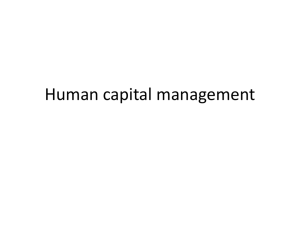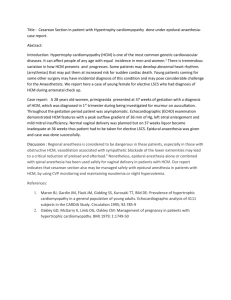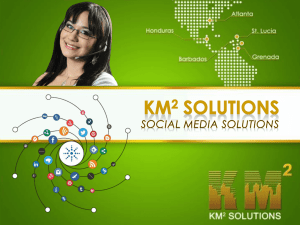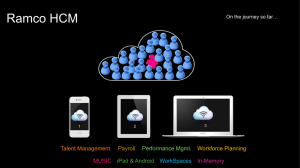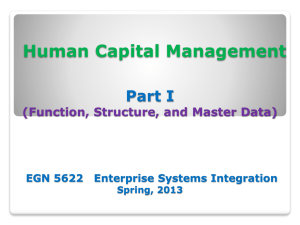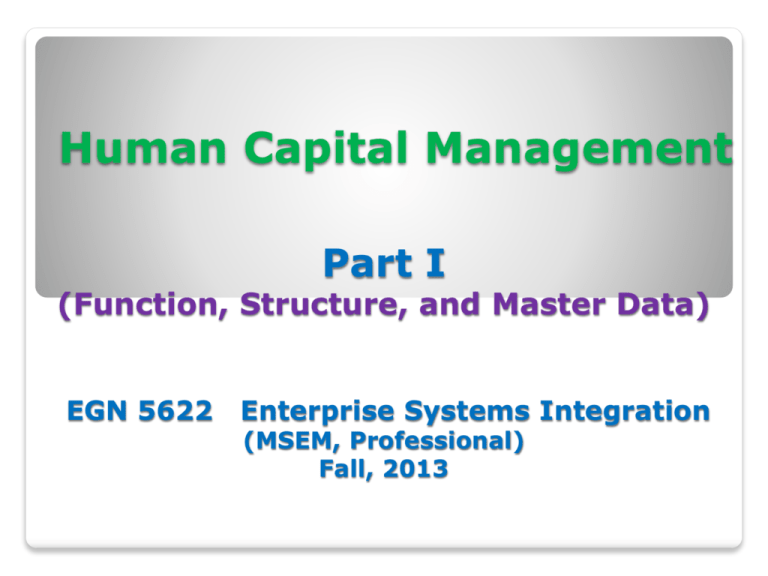
Human Capital Management
Part I
(Function, Structure, and Master Data)
EGN 5622
Enterprise Systems Integration
(MSEM, Professional)
Fall, 2013
Human Capital Management
Part I
(Function, Structure, and Master Data)
Concepts & Theories
Human Resources Management
Manage requirements for human
resources to support company current
needs and future growth, including:
◦
◦
◦
◦
Planning,
Hiring/assigning,
Training, and
Evaluating employees
Human Resources Management
Typical HR Functions:
Planning and job analysis,
Recruitment and selection,
Training and development,
Performance management,
Compensation and benefits, and
Employee and labor relations.
HCM Process in the Employee Lifecycle
Leveraging HCM for Organizational
Performance Improvement
Human Capital Management
SAP Implementation
SAP Module View
Financial
Accounting
Sales &
Distribution
Materials
Mgmt.
Controlling
R/3
Production
Planning
Human
Resources
Quality
Maintenance
Fixed Assets
Mgmt.
Integrated Solution
Client / Server
Open Systems
Plant
Management
Project
System
Workflow
Industry
Solutions
Human Capital Management
Human Capital Management (HCM) modules in SAP
R/3 incorporates HCM concepts and practices,
enabling managers to perform transactions pertaining
to the HRM cycle of events.
HR modules in SAP R/3:
Organizational management
Personnel management,
Payroll
Time management
Training and event management,
Travel management,
Manager’s desktop
Environment, health and safety
Organizational Management
It provides the basis for structuring personnel
planning and development processes, and is
necessary for personnel administration.
Using this application, an organizational structure,
including departments, jobs, positions, and tasks,
can be created.
Work is further defined and described through the
process of job analysis: the cornerstone of HRM.
Organization Management
Organizational Plan
Expert mode
Info system
Tool
Setting
Personnel Management
Personnel administration
Recruitment
Personnel development
Benefits
Compensation management
Personnel cost planning
Management of global employees
Personal Administration
Facilitates the management of HR master
data, personnel files, and relational data
bases.
Maintaining accurate and confidential
employee records is critical to this function.
Personnel Administration
HR master data
◦ Personnel actions
◦ Personnel files
Info system
◦ Report
Employee
Organizational entity (Headcount changes, headcount
development, salary accounting to seniority, assignment to
wage level)
Age/gender
Setting
◦ Define organizational unit
◦ Define positions
◦ Define jobs
Recruitment and Selection
Transactions enable the advertising of position
vacancies, the identification of recruitment
sources, and the hiring of employees.
Additionally, qualifications required of vacant
positions can be matched with the qualifications
of applicants to facilitate decision making in the
selection process.
This functionality in SAP R/3 relates to
recruitment and selection in HCM.
Personal Development
Pertains to performance appraisals, career and
succession planning, and career development.
Performance appraisals help facilitate decisions
regarding promotions, merit pay, and
terminations.
Transactions in SAP R/3 relate to the typical HCM
practices associated with performance
management systems.
Benefits
Benefits pertains to flexible spending
accounts, 401(k) plans, health care accounts,
as well as mechanisms to track costs of
benefits.
SAP R/3 extend far beyond the typical benefits
required by law.
Compensation Management
It is essential in promoting internal equity and
external competitiveness.
Features of this application include job pricing,
reviewing salary surveys, and creating policies
and budgets.
HCM Process: Compensation & Benefits
Compensation is not the cut-and-dry subject it
once was
◦ Past – consisted of an employee's base salary or, at
most, a base salary and commission.
◦ Today - looked at as compensation packages; including:
salaries, stock options
employee stock ownership plans
pay-for-performance plans
bonuses, profit sharing
commissions, non-cash rewards
variable pay, and much more.
January 2007 (v1.0)
© 2007 by SAP AG. All rights
reserved. SAP University Alliance.
The Rushmore Group, LLC
19
HCM Process: Compensation
Management
The balancing of company interests to operate
within the company's fiscal budget and fairly
paying employees
◦ key component of attracting, developing, retaining, and
rewarding high quality staff through wages and salaries
which are competitive in the labor markets
Compensation Management is comprised of the
following components:
◦
◦
◦
◦
Job Pricing
Budgeting
Compensation Administration
Long-term Incentives
January 2007 (v1.0)
© 2007 by SAP AG. All rights
reserved. SAP University Alliance.
The Rushmore Group, LLC
20
HCM Process: Benefits Administration
benefits today are offered as a part of an employees
overall compensation package
this component allows a company great flexibility in
creating and maintaining individual packages for your
employees
◦ Six international Plan Categories
Allows for detailed company reporting
◦
◦
◦
◦
Benefit Plan Participation
Health Plan Costs
Employee Demographics
Benefits Election Analysis
Country Specific Settings available
◦ FSA, COBRA (US examples)
HIPPA Certificates
January 2007 (v1.0)
© 2007 by SAP AG. All rights
reserved. SAP University Alliance.
The Rushmore Group, LLC
21
Payroll
Release payroll
Start payroll process
Check payroll
Correction
Simulation
Follow up
Tax
Overpayment recovery
Bank transfer
HCM Process: Payroll
Administration
SAP contains an international payroll driver
that is modified for each country
payroll is released for individual payroll
areas
◦ the run is for a specific group of employees and
a specific period of time
◦ upon release all affected personnel records are
locked
will generate an payroll results, and
earning statement, bank transfers and
check payments
January 2007 (v1.0)
© 2007 by SAP AG. All rights
reserved. SAP University Alliance.
The Rushmore Group, LLC
23
HCM Process: Payroll
Administration
Payroll Process
◦ Determine Gross Amount
base pay and any other additional payment
◦ overtime, sick pay, Christmas bonuses, special pay
◦ Determine Deductions (Net Amount)
processes garnishments, deductions, taxes, and
benefits for employees
◦ Federal/State Income Tax, Insurance (Health, Life),
Loans
◦ Integration with Financial Accounting &
Controlling
G/L postings, payments processed, reports
available
© 2007 by SAP AG. All rights
January 2007 (v1.0)
reserved. SAP University Alliance.
The Rushmore Group, LLC
24
Overview of the Payroll Process
Payroll Accounting
Calculation of Remuneration Elements
Time Management
Shift planning
Administration
Time data
Time evaluation
Work schedule
Incentive wages
Time sheet
28
HCM Process: Time
Management
supports planning,
recording, and
evaluation of internal
employee time data
time data that would be
gathered and evaluated
◦
◦
◦
◦
◦
◦
hours worked
leave
illness
overtime
substitutions
business trips
conference, training
January 2007 (v1.0)
© 2007 by SAP AG. All rights reserved. SAP University Alliance. The Rushmore
Group, LLC
29
HCM Process: Time Management
There are multiple methods for data collection:
Time Administrators
Time Manager’s Workplace
Time Terminals
Cross Applications Time Sheet
Employee Self Service
Mobile Technology
January 2007 (v1.0)
© 2007 by SAP AG. All rights reserved. SAP University Alliance. The Rushmore
Group, LLC
30
HCM Process: Time Management
Time collection will be used for:
◦
◦
◦
◦
◦
◦
◦
payroll accounting
personnel cost analysis
internal cost allocations
invoicing
performance analysis
capacity availability
shift planning
January 2007 (v1.0)
© 2007 by SAP AG. All rights
reserved. SAP University Alliance.
The Rushmore Group, LLC
31
Time Management Process
Training and Event Management
It involves the management of employee activities
associated with training, workshop attendance,
and other business-related events.
Information on descriptions of programs,
prerequisites, and cost factors can be generated.
This functionality in SAP R/3 relates to training
and development in HCM.
Travel Management
It enables organizations to monitor the
controllable expense associated with travel,
training, and entertainment.
Employees frequently travel on business, so
managing this expense is essential
Manager’s Desktop
It is a tool which enables managers to access
employee information at a manager’s fingertips,
i.e., managers do not have to access menu paths
or transaction codes to retrieve employee
information. Rather, through decentralization of HR
tasks and responsibilities, managers can easily
access HR data of subordinates, both directly and
indirectly supervised, to perform administrative
and organizational tasks, and to make strategic
decisions
Business Process Integration
FI MM HCM SD PP
Rules
FI
MM
PP
SD
January 2008
HCM
© SAP AG - University Alliances and
The Rushmore Group, LLC 2008. All
rights reserved.
36
Business Process Integration
HCM
Rules
HCM
January 2008
© SAP AG - University Alliances and
The Rushmore Group, LLC 2007. All
rights reserved.
37
Organizational Data in HCM
A hierarchy in which the organizational
units in an enterprise are arranged
according to task and functions
Are static data and are rarely changed
The definition of organization units is a
fundamental step, it is a critical factor in
how the company will be structured
Structures of HCM
Enterprise structure
Personnel structure
Organization structure
Structures of HCM
Enterprise Structure
Personnel Structure
Organizational Structure
Enterprise Structure
This structure makes up the legal identity of the
company
Every employee in an organization is included in
the structure of his or her enterprise. The
Enterprise Structure sub-divides organizations
and employees according to factors relevant to
time management and payroll.
The Enterprise Structure is made up of the
following elements:
Client
Company Code
Personnel Area
Personnel Sub-area
Enterprise Structure (-continued)
Client is the major organization criterion in
the system, and is a self-contained unit.
◦
Client has technical structure feature
Personnel data entered in a client can only be
accessed in that client.
Data cannot be exchanged among clients.
If employees change clients, data have to be recreated in that new client.
Enterprise Structure (-continued)
Company code is an independent
accounting unit, and is also selfcontained.
A set of accounts can be developed in the
company code, and financial statements such
as balance sheets and profit-and-loss
statements are created at this level.
Enterprise Structure (-continued)
Personnel area represents the “company and
country version for payroll” view.
It used primarily in personnel administration, is
unique within a client, and is a sub-division of the
company code based on locations or divisions.
It serves as a selection criterion for reporting,
constitutes a unit in authorization checks, and
allows one to generate default values for data
entry, e.g., for the payroll accounting area.
Enterprise Structure (-continued)
Personnel sub-area represents the “location and
public holiday calendar” view.
It is subdivision of a personnel area (such as a
department), and identifies groupings of employees
assigned to a particular personnel area or company
code.
It is the level at which the primary organizational
aspects of human resources are controlled. Its
functions include specifying a country grouping, setting
groupings for time management so that work schedules
can be set up for individual personnel sub-areas,
generating a default pay scale type and area for basic
pay.
sub-area must be unique to a company code
Enterprise Structure
Enterprise Structure
Enterprise Structure: Global
Bike Group
Global Bike Group
Global Bike US
Marketing & Sales
Administration
Security
Global Bike Germany
Aministration & Financials
Financials
Operations
Personnel Structure
This structure sub-divides organizations
and employees according to factors
relevant to time management and payroll.
The Personnel Structure is made up of the
following elements:
◦ Employee Group
◦ Employee Subgroup
◦ Payroll Area
Personnel Structure (-continued)
Employee group is the highest level, and
defines the relationship between an employee
and a company in terms of work, i.e., active
employees, pensioners, and early retirees.
These groups can be differentiated further. For
example, an active employee may also be a
trainee, an hourly wage earner, a salaried
employee, etc.
The principal functions of the employee group
include generating default values for payroll
accounting area and basic pay, serving as a
selection criterion for reporting, and serving as a
unit in authorization checking.
Personnel Structure (-continued)
Employee sub-group enables distinguishing
among employees specifically with regard to
their status. For example, active employees may
be classified as a trainee, hourly wage earner, non
pay-scale employee, salaried employee, etc.
Functions include allowing different payroll
procedures for different employee subgroups,
controlling the validity of wage types on an
employee sub-group level, and defining the
validity of work schedules, attendance and
absence quotas.
Personnel Structure
Personnel Structure: Elements
Payroll Area
◦ It groups employees together that are paid the
same (time)
Weekly, Bi-Weekly, Monthly
◦ The payroll area is determined from a
combination of the Employee Group and
Employee Subgroup
number of employees in the payroll run
specific dates of the payroll run
Organization Structure in HCM
The organizational structure and plan is the
comprehensive model of the structural and
personnel environment in the enterprise, with
hierarchies and reporting relationships clearly
defined.
Hierarchies and reporting relationships are
determined once object types are created.
Typical object types include
◦
◦
◦
◦
◦
organizational units,
jobs,
positions,
tasks, and
persons.
Organizational Structure
• Using organization and planning, you can get a clear picture of
your organization at any point in time: past, present or future.
With this information, you can be proactive in planning for future
human resource needs.
Organizational Structure: Pen Inc
Organizational Units
Position
Person
January 2007 (v1.0)
Organization Structure (-continued)
Organizational units reflect the various
business units or departments in the
enterprise.
Several organizational units can be created, and
they must be related to one another in an
organizational plan. They can be defined as
functional, divisional, or geographical departments,
or as project groups.
An example of a functional structure would include
accounting, sales, human resources, and
manufacturing departments.
Organization Structure (-continued)
Jobs reflect the tasks, duties and
responsibilities of the work being performed
in the organization.
Typically, they are grouped in terms of the
similarity of tasks being performed, and are more
generic in nature. Some examples include analyst,
specialist, manager, and supervisor.
Organization Structure (-continued)
Positions are more specific than jobs, and all
of the information stored in a job is inherited
by all of the positions created from the job.
Positions reflect individual employee assignments,
and are occupied by persons.
Examples of positions include Accounting Analyst,
Logistics Specialist, Compensation and Benefits
Manager, and Production Supervisor.
Organization Structure (-continued)
Persons are assigned to positions in the
organizational structure, and generally
represent the employees in the company.
For example, Ross Quarles may be the Accounting
Analyst, Fawzi Noman may be the Logistics
Specialist, Kathy Utecht may be the
Compensation & Benefits Manager, and High Asa
Kite may be the Production Supervisor.
Organization Structure (-continued)
Tasks are the individual duties and
responsibilities undertaken by employees
in their positions, as reflected in their job
descriptions.
Examples of tasks include “prepares accounting
reports,” “maintains warehouse inventory,”
“reviews salary surveys,” and “oversees
production scheduling.”
Organizational Structure
Integration of Org. Mgt. with Personnel
Admin.
Integration of Org. Management with
Personnel Admin.
HCM: Master Data
Master data is relatively fixed
◦ Record that contains all the necessary information to
conduct business transactions
◦ Information within a master record can and will change, our
hope is that it does not change frequently.
Before making the master data
configurations, you must have completely
defined the organizational structures
HCM: Master Data Master Data
A vast amount of HR data can be maintained in SAP R/3.
Personnel data provide the basis for various HR transaction
processing and reporting. Hence, its accuracy, timeliness,
relevance, and completeness are crucial.
While most data may be housed in an HR department’s
information system, it is important that data that pertaining
to an overall HR information system be included.
Typically, the data pertains to employee information which
is entered into the system using
infotypes (types of information) and
HR Master Database which stores Infotypes.
HCM: Master Data (-continued)
Infotypes categorize information and enable
data input, i.e., they are data entry screens
which allow the entering of various types of
information into data fields.
Similar types of information can be grouped by
content to facilitate data entry.
Infotypes can be processed individually or through
the fast entry mode (entering specific data for
several employees at once).
HCM: Master Data (-continued)
Processing of infotypes may include creating
(creating a new record with beginning and end
dates), changing (changing or correcting a record),
copying (using the initial record as a template),
delimiting (upon entering a delimitation date,
records valid for that date are selected, and then
setting the end date for that record to the day
before the delimitation date), and displaying
(viewing but not changing records).
There are over 600 HR infotypes used to maintain
employee and applicant data, and the number,
types, and settings of infotypes can be customized
to fit the business requirements of the company
HCM: Master Data (-continued)
HR Master Database is where HR data are
stored. Typically, employee information is
stored in a personnel file which can be
accessed by entering the employee’s
assigned personnel number (usually generated
internally by the system).
Several records of information on an employee can
be reviewed, such as organizational assignment,
basic pay, addresses, travel preferences, planned
working time, etc.
HCM: Master Data (-continued)
Information can also be retrieved in a
relational database format by accessing
specific infotypes.
For example, if a manager wants to review the
basic pay of an employee, the manager does
not have to access the personnel file and
review all of the records until basic pay is
reached. Rather, the basic pay infotype (i.e.,
0008) can be accessed directly so that only
that information is retrieved.
HCM: Master Data - Employee Data
Information must be recorded and
maintained effectively for every employee
◦ Infotypes (Information Types) are units of
information that aid in the entry of master data
and group like information together
Status of the Employee will determine
what information should be gathered
◦ Active vs. Intern
◦ Exempt vs. Non-exempt
Employee Data: Infotypes
Numerous infotypes will be created for each
employee
◦ Organizational Assignment must be the first infotype recorded
Employee Data: Infosubtypes
Certain data that is entered in an infotype can
trigger the need for a infosubtype
◦ ex. Family Member/Dependents
If you enter that you are married or have children it will
generate the need for a spouse/child infosubtype to capture
the information about the spouse or child(ren)
Subtypes also allow you to account for time
constraints
◦ Different addresses may be current at the same time
Permanent Residence
Temporary Residence
Home address
Employee Data: Personnel Actions
Personnel actions are a series of
predefined infotypes that are grouped
together to speed the data entry process
◦ Hiring, Firing, Reassignment, Retiring – would
all be examples of procedures that could be
represented by a Personnel action
Personnel Actions enable users to enter
information about an employee without
having to access each individual infotype
Personnel File
• Information maintained about an employee is stored in their
Personnel File
HCM: Employee Lifecycle
Birth
Death (Retire)
Work
January 2007 (v1.0)
Taxes
HCM: Process/Functions
Hire
Employee
Recruitment
Training and
Development
Cost Planning
Reporting
ESS
Employee
Self-Service
Payroll
Administration
Manage Work
Time (CATS)
Compensation
& Benefits
SAP GBI Client, Userid, Password
SAP Exercises HW7 & HW8:
Description: SAP BASEL Fall 2013
Application server:
basel.cob.csuchico.edu
Instance number: 26
System ID: BAS
Client: 270
Userid: gbi-012 to gbi-050
Initial password: SAP4US
Exercises: (due date 10/5/2013)
HCM
HCM
HCM
HCM
HCM
HCM
HCM
HCM
HCM
HCM
1: Display Organization Plan.
2: Display personnel master record
3: Create positions
4: Create Career
5: Define requirement
6: Hire employee
7: Display organizational plan
8: Post job advertisement
9: Enter applicant master data
10: Prepare hiring

